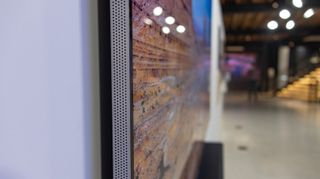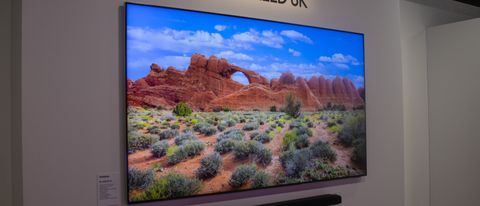Early Verdict
The Neo QN800 QLED TV is Samsung's best offer to get early adopters to buy a brand new 8K television in 2021. It's sure to be expensive, but it's not the top-of-the-line QN900 series. It should come in at a cheaper price than Samsung's flagship 8K TV, yet boast the same brightness levels and AI upscaling.
Pros
- +
Very bright 8K display
- +
Slims bezels
Cons
- -
It's likely to be expensive
- -
Not much 8K content to watch
Why you can trust TechRadar
Voted Best 8K TV at the TechRadar Choice Awards 2021
UPDATE: The Samsung QN800 QLED has now got pricing and a March 13 release date for the US. It's starting at $3,499 (around £2,500 / AU$4,500) at a 65-inch size, a small increase over the $3,199 starting price of last year's Q800TS. Larger sizes will see this amount go up to $4,799 for the 75-inch and $6,499 for the 85-inch.
We'll update this page when more info is available for other countries, but in the meantime you can read our initial thoughts about Samsung's Neo QLED TV below...
Meet the Samsung Neo QN800 QLED, the new 8K TV that's part of Samsung's plan to make massive 8K television purchases the norm among early adopters in 2021.
We got to see the 75-inch version of this 8K TV in person ahead of CES 2021 and can attest that, like its slightly better sibling, the Samsung Neo QN900, this TV set is big, bright and beautiful. It was hard to look away at the native 8K resolution video loop.
A lot of this praise comes down to the brighter display care of Samsung shrinking down the LEDs to 1/40th their traditional size. This allows for tighter LED clusters and for the TV's processor to do micromanaging over what you see on the screen.
The QN900, which looks good at any angle, has more precision and that translates into a brighter picture with deeper black levels. Gone is the blooming effect where illuminated objects would bleed into darker portions of the picture. Samsung is bent on erasing the black level advantage of OLEDs in 2021.
The QN800 has incredibly thin bezels, though Samsung's matrixing technology that reduces the gap between where the pixels end and bezel begins is exclusive to the company's top-of-the-line Samsung Neo QN900 TV QLED 8K TV. The N900 also has better HDR performance (Quantum HDR 64x vs HDR 32x on this QN800 set).
The fact that the Samsung Neo QN800 has any sort of bezel and impressive-but-not-the-best HDR performance means you'll be paying slightly less for this 8K TV than the top-of-the-line QN900.
That's why this QLED TV may be more important for ushering in a new generation of 8K TVs in 2021 than any other television in the coming months.

It's hard to recommend an 8K television to the average consumer when there are no mainstream streaming 8K video platforms out there. It's mostly tech demos: 8K time lapses of landscapes and a few reels of nature. The world just embraced 4K, which was stuck at this point about eight years ago.
Samsung is remedying this with its Multi-Intelligence AI upscaling feature, promising better-than-4K quality fit for such a large television. That's something we'll be taking a closer look at when we do a full Samsung Neo QN800 8K QLED TV review.
Samsung's Neo QLED TVs integrate their speakers into the sides of the frame, so the right and left sides are perforated with speaker grille. Not only does this holy look give the set a cool aesthetic, the audio and Samsung's Object Tracking Sound should benefit by coming from the sides, not the back of the TV.

Samsung's QN800 obviously has a lot of processing going on, but there's a breakout box, so not all of that happens behind the TV panel. This keeps things a bit thinner – though, this TV has a bit of girth to it, so it's not one of those ultra-thin TVs.
Samsung's redesigned breakout box once again connects to the display via a single cable and, this year, can be attached to the stand or the back of the TV if you don't want it hanging out inside your media cabinet. It's going with the name 'Attachable Slim One Connect' for this all-important box.

Early verdict
Samsung is offering early adopters two choices when it comes to buying an 8K TV in 2021, and the Neo QN800 is the cheaper of the pair next to the QN900. You're only missing out on the truly bezel-less look and enhanced HDR performance. The QN800 is no slouch in either category and you're bound to save a bunch of money.
The 75-inch Neo QN800 we saw had noticeably increased brightness levels and the blacks did seem deeper over the previous generation of QLEDs, and that's care of smaller, more tightly clustered LEDs. Samsung is doing everything to make its TVs look good in the dark room (always a benefit of good OLEDs) as they do in a bright room (the cornerstone of LED and QLED sets).
Will the QN800 be affordable enough for spendy early adopters who don't need the top-of-the-line QN900? We don't have final prices for either TV, and don't expect the QN800 to be 'cheap' necessarily – the Samsung Q950TS 85-inch 8K TV last year started at $12,999 / £11,999. A lot of this 8K TV's potential comes down to price.
- Check out every new Samsung TV coming this year
What is a hands on review?
Hands on reviews' are a journalist's first impressions of a piece of kit based on spending some time with it. It may be just a few moments, or a few hours. The important thing is we have been able to play with it ourselves and can give you some sense of what it's like to use, even if it's only an embryonic view. For more information, see TechRadar's Reviews Guarantee.


